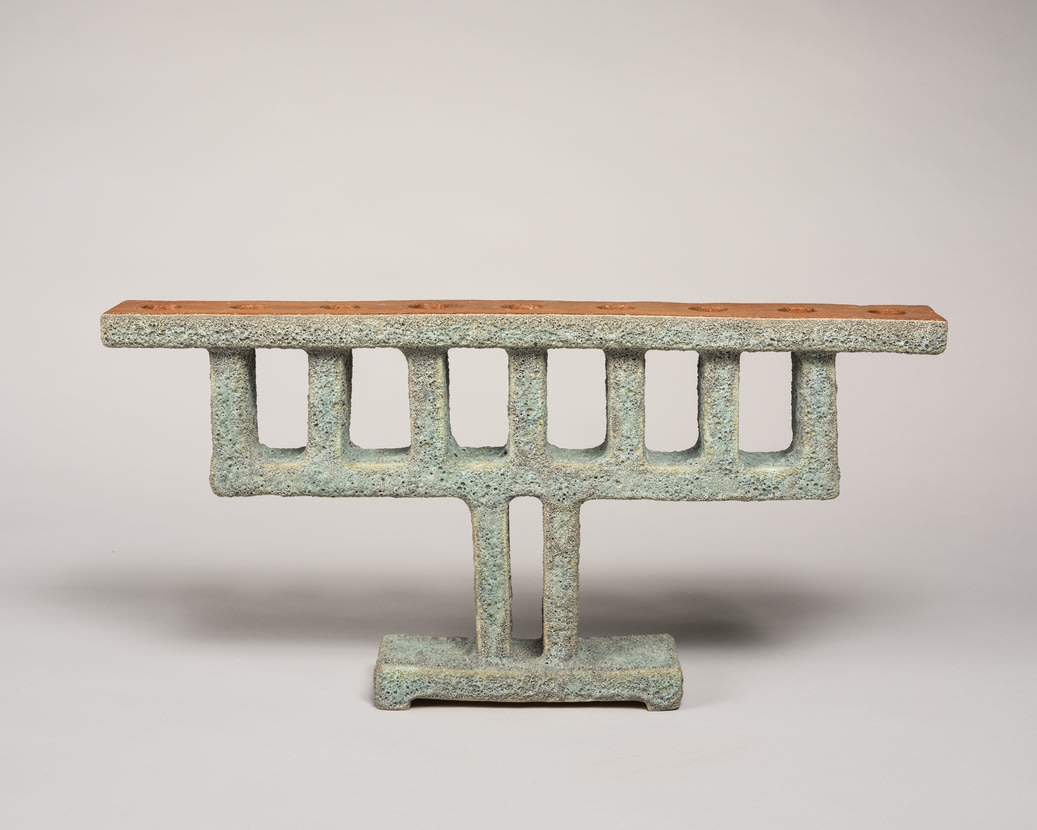
- Object Name:
- Hanukkah Lamp
- Artist/Maker:
- Otto Natzler
- Bio:
- American, b. Austria, 1908-2007
- Place Made:
- Simi Valley, California, United States
- Date:
- 1956
- Medium:
- Earthenware with lava glaze
- Dimensions:
- 8 1/8 × 16 3/4 × 2 1/4 in. (20.6 × 42.5 × 5.7 cm)
- Credit Line:
- Purchase: Judaica Acquisitions Fund and Gift of Mimi R. T., Ruth I. and Lewis D. Surrey in honor of Albert W. Surrey
- Accession Number:
- 1988-30
Not On View
Gertrud and Otto Natzler's fascination with ceramics began in 1930s Vienna, where they met, formed a relationship, and launched their careers as ceramists. Their training was largely a self-taught experience fraught with trial and error, which Otto later characterized as a "series of accidents." It often consisted of tireless experiments that gradually revealed to them how they could achieve a specific shape or glaze effect. For example, Otto conducted more than 2,500 glaze experiments and kept copious records of the results, giving him a repertoire of surfaces and finishes that would later bring them much acclaim and success. Gertrud devoted herself to the creation of the vessels, and her uncanny sense for shape and line was described by Otto as a kind of innate "feeling for form" (Formgefühl): "At times I had the feeling in observing her turning or throwing that literally one millimeter change in one dimension meant the difference between day and night to her." As a team, the Natzlers created strikingly beautiful forms with remarkable surface finishes.
The Natzlers focused on ceramics as a sculptural and artistic medium, rather than as a vehicle for functional objects, which may explain why ceremonial objects were never a high priority for them. However, in 1956 Shlomo Bardin, founder and director of the Brandeis Institute (now the Brandeis-Bardin Institute) in California, encouraged them to explore Judaica. From 1956 until 1960, the Natzlers served as artists-in-residence and instructors at Brandeis Camp Institute, which offered intensive studies in Jewish-related subjects and the arts for college-age students. Bardin persuaded the Natzlers to create Yahrzeit (memorial) lamps for the Brandeis collection. Each lamp that the couple created was inscribed with the Hebrew text that translates as "Man comes from dust and returns to dust."
During their years at Brandeis, Otto Natzler also began making slab-constructed Hanukkah lamps, such as The Jewish Museum's example. Unlike Gertrud's sinuous, wheel-thrown forms, Otto's work was slab-built and architectural in feeling. The Jewish Museum's lamp, which dates to 1956, is coated with a gray-green glaze that Otto first developed in 1940 and called "lava." It was precisely the type of surface treatment for which the Natzlers were known, and capitalizes on what some people would view as glaze defects-craters and rough surface texture. Otto purposely cultivated these glazes to evoke "what has been done by nature in the process of earth's creation." The verdigris color and encrusted surface also have associations with the antique and may recall the ancient story of Hanukkah.
The Natzlers' body of Judaica is small and rarely seen, yet the pieces are informed by a spiritual quality and evince a mood of quiet contemplation.
The Natzlers focused on ceramics as a sculptural and artistic medium, rather than as a vehicle for functional objects, which may explain why ceremonial objects were never a high priority for them. However, in 1956 Shlomo Bardin, founder and director of the Brandeis Institute (now the Brandeis-Bardin Institute) in California, encouraged them to explore Judaica. From 1956 until 1960, the Natzlers served as artists-in-residence and instructors at Brandeis Camp Institute, which offered intensive studies in Jewish-related subjects and the arts for college-age students. Bardin persuaded the Natzlers to create Yahrzeit (memorial) lamps for the Brandeis collection. Each lamp that the couple created was inscribed with the Hebrew text that translates as "Man comes from dust and returns to dust."
During their years at Brandeis, Otto Natzler also began making slab-constructed Hanukkah lamps, such as The Jewish Museum's example. Unlike Gertrud's sinuous, wheel-thrown forms, Otto's work was slab-built and architectural in feeling. The Jewish Museum's lamp, which dates to 1956, is coated with a gray-green glaze that Otto first developed in 1940 and called "lava." It was precisely the type of surface treatment for which the Natzlers were known, and capitalizes on what some people would view as glaze defects-craters and rough surface texture. Otto purposely cultivated these glazes to evoke "what has been done by nature in the process of earth's creation." The verdigris color and encrusted surface also have associations with the antique and may recall the ancient story of Hanukkah.
The Natzlers' body of Judaica is small and rarely seen, yet the pieces are informed by a spiritual quality and evince a mood of quiet contemplation.
Information may change as a result of ongoing research.